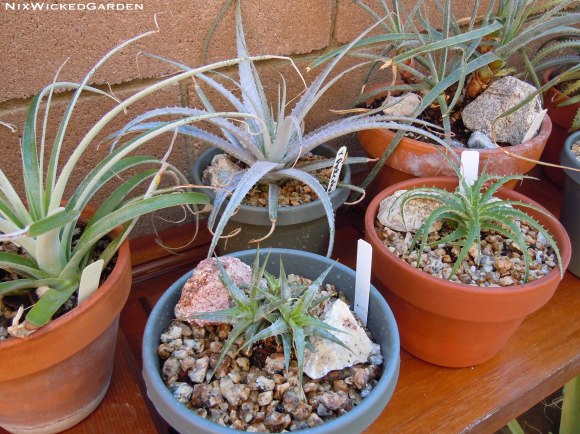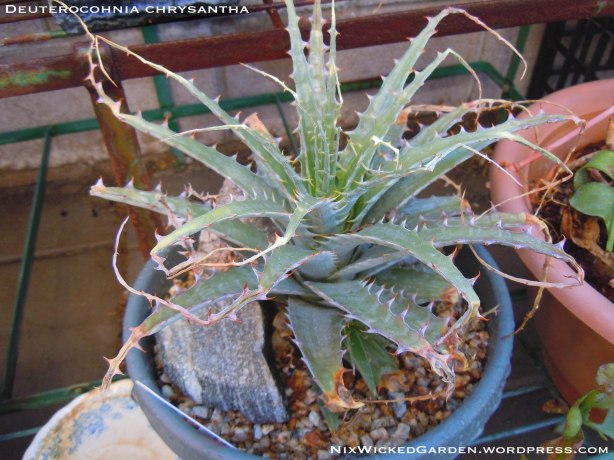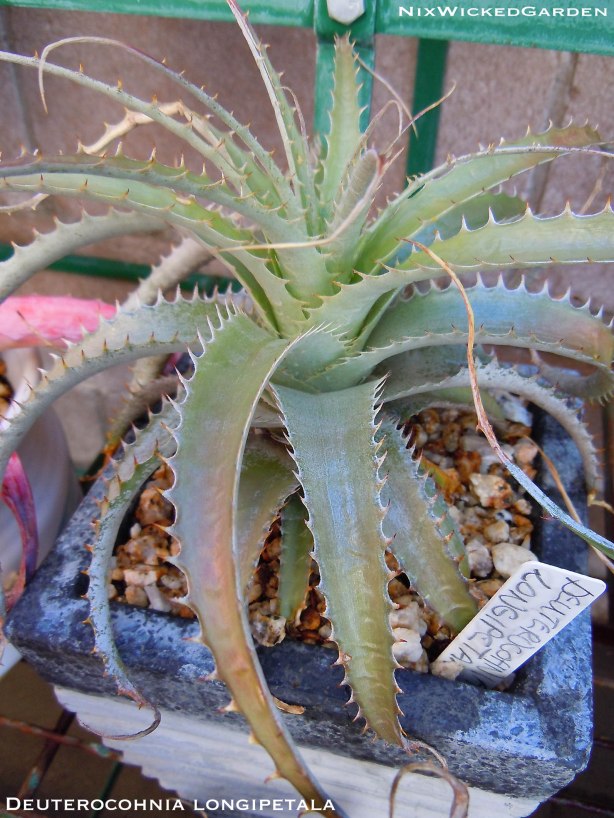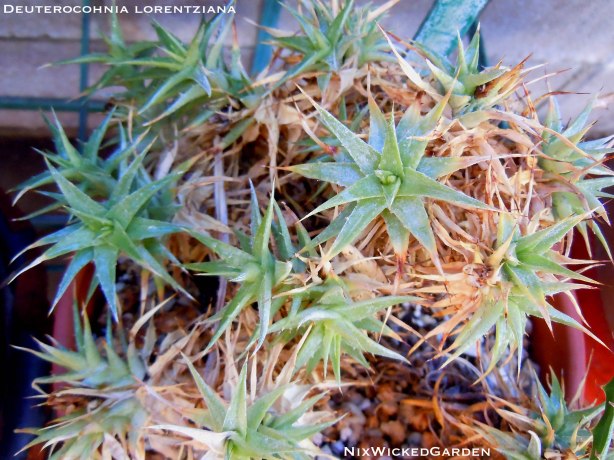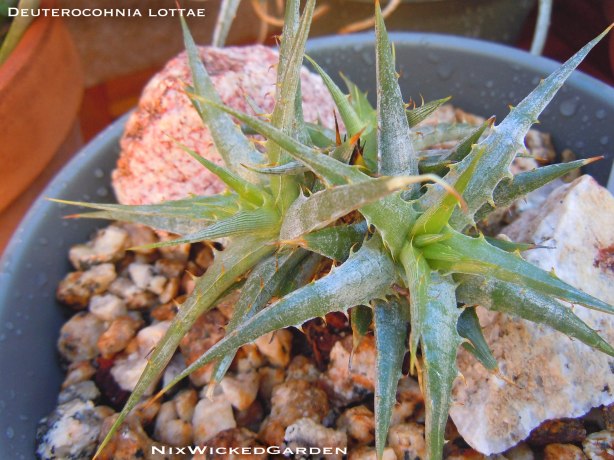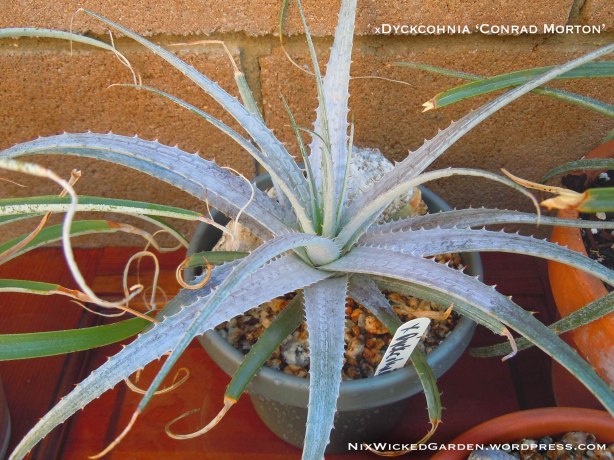First off: HAPPY NEW YEAR! I meant to post a blog entry sooner, but I have actually been down with some-kind-of-sickness FOR DAYS–weeks, really! I got a Flu-shot my doctor’s office on November 2nd…That is what started it off, I think. I was sick most of November, was OK for a couple of weeks–then sick again a week or so before X-Mas, fine for X-Mas, then SICK AS A DYING DOG the day after. Needless to say, New Year’s Eve was spent bundled up in bed coughing and sneezing. Barely feeling better today—My birthday is tomorrow (YAY!) Not really, yay—No merry-making for me! I can’t afford to get sick again!!! 😦
I was browsing through plant-forums today and read some very saddening news. Dutch Vandervort passed away in December. He was a very nice man and a major Plant Aficinado. I bought many Terrestrial Bromeliads from him when he had his Greenhouses near Ventura, Ca. I had just gotten an e-mail from him November 7th about a plant I bought from him many years ago that I was trying to I.D. We had last spoken about trading some pups from our plants with each other…. What a bummer! He was always so helpful and would help anyone he could especially with questions about Bromeliads. At least I have many beautiful plant colonies from him that continue to amaze me everyday with their unique characteristics and wicked allure. Rest In Peace, Dutch! You will be greatly missed…
Well, this great “Plant Guru”, Dutch, introduced me to Deuterocohnia. Currently recognized in the subfamily Pitcairnioideae. Named in honor of German botanist and bacteriologist Ferdinand Julius Cohn (1828-1898). There was already a genus Cohnia, so the Greek prefix deuterios, second, was placed in front to form a new generic name.
I don’t have many of these beauties, mostly because they are rather hard to find (& hard to find AFFORDABLY!) If I remember correctly, there are just 18 species of Deuterocohnia and just a few recognized hybrid Cultivars. I try to pick them up whenever I find one online that I don’t have. If they are priced very well—I’ll even purchase doubles. They grow fairly slowly and since I would like to have plants available to trade with other collectors in the future, it doesn’t hurt to have many healthy clones. I would like to eventually have all the different species of Deuterocohnia. Heck, by THAT time there will probably be a whole slew of newly discovered species. Like I mentioned before: Trying to get them all gives me a reason to get up in the morning!<LOL>
My favorite Deuterocohnia that I own is Deuterocohnia meziana. A medium-sized rosette plant but has a very tall yellow, orange or red inflorescence when blooming. One unique and unusual characteristic of this plant, is the lofty inflorescence keeps flowering from the same stem for a period of 5-7 YEARS!!! (That is a welcomed trait considering so many Bromeliads die off after they bloom and one has to re-pot the mother-plants pups to continue to propagate the plant). Deuterocohnia meziana is native to Bolivia, Brazil and Paraguay, where it grows in the deserts, steep talus, crevices, barren lands or over huge rocks, heated by the torrid tropical sun.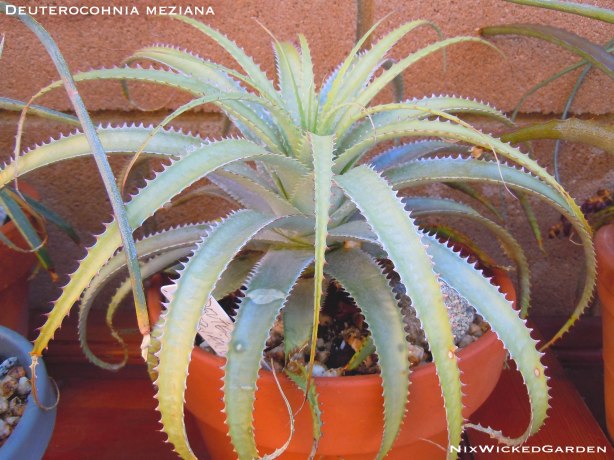
Another Deuterocohnia that looks very similar to D. meziana is, Deuterocohnia longipetala. This plant widely distributed from Peru, Chile and Argentina. It is also a drought-resistant plant, growing in the lonely deserts on bluff escarpments, in rocky briery spots or barren lands. It’s blooming period is of “long duration” but not nearly as extreme as D. meziana! Another stunning desert Bromeliad is Deuterocohnia chrysantha. This plant is native to northern Chile, where it grows in extremely dry areas and in some places obtains much of its water from coastal fog. It forms clusters of rosettes usually among rocks. The leave margins are heavily armed and can turn a bright pinkish red when stressed.
Deuterocohnia lorentziana is from Cuesta de la Chilca, Catamarca, Argentina. It’s been called Abromeitiella for years but is actually a dwarf Deuterocohnia with short spikey armed leaves that forms tall trunks as it grows. I’ve had this little guy for quite a few years and it blooms tiny single greenish-yellow flowers. Another dwarf Deuterocohnia that I have is Deuterocohnia lotteae. This one is from Southern Bolivia. it grows into little mound-like colonies that look not unlike large green pin-cushions. This one has dark-orange red flowers with lime green petal tips. This plant was hard to find and I was lucky enough to acquire it from Andy Siekkinen (President of the Bromeliad Society San Diego). He listed several plants on eBay and I may have also bought one or two—ALL RIGHT, MORE THAN A COUPLE, OKAY!!! I know, I know…I have a PROBLEM!! 😦
The last plant I wanted to add here is a Bigeneric hybrid of seed parent: Dyckia macedoi and pollen parent: Deuterocohnia meziana. The registered name of the plant is xDyckcohnia ‘Conrad Morton’. Hybridized by Paul Hutchinson. One of the cool things about this plant is that it has the blooming characteristic of Deuterocohnia meziana, in that once the plant enters its bloom cycle, it continues to grow new inflorescence bracts off the side of the first dried bract on the same bloom stalk!! I have heard this going on for 3-5 cycles. Amazing! As someone who loves when my Dyckia and Aloes bloom, but all-to-soon am disappointed when the bloom cycle is over—the anticipation of seeing this guy bloom for months on end is just WAY too exciting an idea. Especially since we have so many varieties of Hummingbirds here in the Desert! What a treat—I’ll try to get some pics of them feeding from it when it starts blooming! 😉
